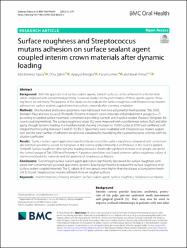| dc.contributor.author | Eşlemez Topçu, Eda | |
| dc.contributor.author | Şahin, Onur | |
| dc.contributor.author | Köroğlu, Ayşegül | |
| dc.contributor.author | Cömert, Füsun | |
| dc.contributor.author | Yılmaz, Burak | |
| dc.date.accessioned | 2022-09-12T10:09:30Z | |
| dc.date.available | 2022-09-12T10:09:30Z | |
| dc.date.issued | 2022 | en_US |
| dc.identifier.uri | https://hdl.handle.net/20.500.12868/1521 | |
| dc.identifier.uri | https://bmcoralhealth.biomedcentral.com/articles/10.1186/s12903-022-02323-x | |
| dc.description.abstract | Background: With the application of surface sealant agents, smooth surfaces can be achieved in a shorter time
when compared with conventional polishing. However, studies on the performance of these agents against chewing forces are not many. The purpose of this study was to evaluate the surface roughness and Streptococcus mutans
adhesion on surface sealent coupled interim prosthetic materials after chewing simulation.
Methods: One hundred and twelve specimens were fabricated from two poly(methyl methacrylate) (Tab 2000,
Dentalon Plus) and two bis-acryl (Tempoft, Protemp 4) interim crown materials and divided into 4 groups (n=7)
according to applied surface treatment: conventional polishing (control) and 3 surface sealant (Palaseal, Optiglaze, Biscover) coupling methods. The surface roughness values (Ra) were measured with a proflometer before (Ra0) and after
aging through dynamic loading in a multifunctional chewing simulator for 10,000 cycles at 50 N load combined with
integral thermocycling (between 5 and 55 °C) (Ra1). Specimens were incubated with Streptococcus mutans suspension and the total number of adherent bacteria was calculated by multiplying the counted bacterial colonies with the
dilution coefcient.
Results: Surface sealant agent application signifcantly decreased the surface roughness compared with conventionally polished specimens, except for Optiglaze or BisCover LV applied Protemp 4 and Palaseal or Biscover LV applied
Tempoft. Surface roughness after dynamic loading showed a statistically signifcant increase in all groups, except for
the control groups of Tab 2000 and Protemp 4. A positive correlation was found between surface roughness values of
interim prosthodontic materials and the quantitiy of Streptococcus Mutans.
Conclusions: Even though surface sealant agent application signifcantly decreased the surface roughness compared with conventionally polished specimens, dynamic loading signifcantly increased the surface roughness of all
surface sealant coupled materials. The Ra values of all test groups were higher than the plaque accumulation threshold (0.20 µm). Streptococcus mutans adhered more on rougher surfaces | en_US |
| dc.language.iso | eng | en_US |
| dc.relation.isversionof | https://doi.org/10.1186/s12903-022-02323-x | en_US |
| dc.rights | info:eu-repo/semantics/openAccess | en_US |
| dc.subject | Interim materials | en_US |
| dc.subject | Chewing simulator | en_US |
| dc.subject | Surface sealant agent | en_US |
| dc.subject | Surface roughness | en_US |
| dc.subject | Streptococcus mutans | en_US |
| dc.title | Surface roughness and Streptococcus mutans adhesion on surface sealant agent coupled interim crown materials after dynamic loading | en_US |
| dc.type | article | en_US |
| dc.contributor.department | ALKÜ, Meslek Yüksekokulları, ALTSO Turizm Meslek Yüksekokulu, Otel, Lokanta ve İkam Hizmetleri Bölümü | en_US |
| dc.identifier.volume | 22 | en_US |
| dc.identifier.issue | 1 | en_US |
| dc.identifier.startpage | 1 | en_US |
| dc.identifier.endpage | 11 | en_US |
| dc.relation.journal | BMC Oral Health | en_US |
| dc.relation.publicationcategory | Makale - Uluslararası Hakemli Dergi - Kurum Öğretim Elemanı | en_US |


















